
Johann Bernhard Fischer von Erlach was an Austrian architect, sculptor, engraver, and architectural historian whose Baroque architecture profoundly influenced and shaped the tastes of the Habsburg Empire. His influential book A Plan of Civil and Historical Architecture (1721) was one of the first and most popular comparative studies of world architecture. His major works include Schönbrunn Palace, Karlskirche, and the Austrian National Library in Vienna, and Schloss Klessheim, Holy Trinity Church, and the Kollegienkirche in Salzburg.

Liechtenstein Castle is a castle near Maria Enzersdorf in Lower Austria, bordering Vienna. It is on the edge of the Wienerwald. Liechtenstein Castle is the eponymous ancestral seat and place of origin of the House of Liechtenstein, the ruling family of the Principality of Liechtenstein. The family owned the castle from at least 1140 until the 13th century, and again from 1808 to the present.

The House of Schönborn is the name of an ancient noble and mediatised formerly sovereign family of the former Holy Roman Empire.

Johann Lukas von Hildebrandt was an Austrian baroque architect and military engineer who designed stately buildings and churches and whose work had a profound influence on the architecture of the Habsburg Empire in the eighteenth century. After studying in Rome under Carlo Fontana, he constructed fortresses for Prince Eugene of Savoy during his Italian campaigns, becoming his favorite architect. In 1700 he became court engineer in Vienna, and in 1711 was named head of the court department of building. He became court architect in 1723. His designs for palaces, estates, gardens, churches, chapels, and villas were widely imitated, and his architectural principles spread throughout central and southeast Europe. Among his more important works are Palais Schwarzenberg, St. Peter's Church, and Belvedere in Vienna, Savoy Castle in Ráckeve, Schönborn Palace in Göllersdorf, and Schloss Hof.
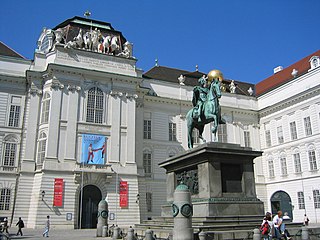
Josefsplatz is a public square located at the Hofburg Palace in Vienna, Austria. Named after Emperor Joseph II, Josefsplatz is considered one of the finest courtyards in Vienna.
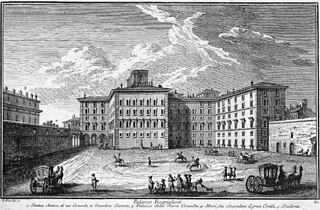
The Palazzo Pallavicini-Rospigliosi is a palace in Rome, Italy. It was built by the Borghese family on the Quirinal Hill; its footprint occupies the site where the ruins of the baths of Constantine stood, whose remains still are part of the basement of the main building, the Casino dell'Aurora. Its first inhabitant was the famed art collector Cardinal Scipione Borghese, the nephew of Pope Paul V, who wanted to be housed near the large papal Palazzo Quirinale. The palace and garden of the Pallavicini-Rospigliosi were the product of the accumulated sites and were designed by Giovanni Vasanzio and Carlo Maderno in 1611–16. Scipione owned this site for less than a decade, 1610–16, and commissioned the construction and decoration of the casino and pergolata, facing the garden of Montecavallo. The Roman palace of this name should not be mistaken for the panoramic Villa Pallavicino on the shores of Lake Como in Lombardy. The Palace has also been the scene of important cultural and religious events. On June 6, 1977 Princess Elvina Pallavicini invited in Palazzo Pallavicini Rospigliosi the archbishop monsignor Marcel Lefebvre for a conference on the Second Vatican Council and for the celebration of a Traditiona Mass, under the careful direction of the marquis Roberto Malvezzi, and Frigate Captain marquis Luigi Coda Nunziante di San Ferdinando. Many members of Alleanza Cattolica, the baron Roberto de Mattei, the pharmacologist Giulio Soldani, the sociologist Massimo Introvigne, the psychiatrist Mario Di Fiorino and Attilio Tamburrini and his brother Renato Tamburrini took part to the event.

The Palais Lanckoroński was a palace in Vienna, Austria, located at Jacquingasse 16-18, in the Landstraße District. It was constructed in 1894-95 for Count Karol Lanckoroński and his family as a personal residence, and it housed the count's enormous art collection. The palace was built in a neo-baroque style by the theatre architects Ferdinand Fellner and Hermann Helmer. The building was three stories high, set back from the street, and protected by a wall with double gates. The entrance hall was wood panelled, two stories high, and decorated with portraits of the family. Other festive halls were decorated with frescoes and luxurious gobelin tapestries from the 17th century. Precious paintings, furniture and sculpture from different eras were arranged to form themed ensembles in the various rooms, with the rooms named to reflect the collection housed within. The palace was severely damaged in World War II, and was torn down in the 1960s.
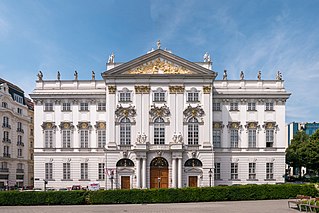
Palais Trautson is a Baroque palace in Vienna, Austria, located at Museumstraße 7. It was once owned by the noble Trautson family.

Palais Schwarzenberg is a Baroque palace in front of Schwarzenbergplatz, Landstraße, the 3rd district of Vienna, Austria. It is owned by the princely Schwarzenberg family.

Palais Augarten is a Baroque palace in the district of Leopoldstadt, Vienna, Austria. Constructed in the late seventeenth century by Johann Bernhard Fischer von Erlach on the site of a Jagdschloss and gardens, the palace and gardens were expanded in the nineteenth century under Emperor Franz Joseph I of Austria. Despite extensive damage suffered during World War II, the palace has been maintained almost in its original appearance, and many of the original furnishings can still be found there. Today, Palais Augarten is the home and rehearsal space of the Vienna Boys' Choir, who also have their own school there. The palace is located in the 130-acre Augarten park, which is the oldest Baroque garden in Vienna.

Palais Lobkowitz, or Palais Dietrichstein-Lobkowitz, is a Baroque palace in Vienna, Austria. It was owned by the noble Lobkowitz family.
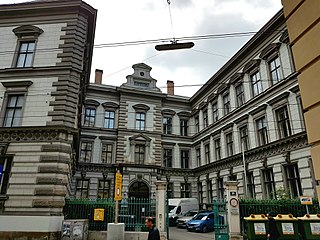
Palais Strozzi is a palace in Vienna, Austria. It was owned by the Strozzi family.

Palais Kinsky is a Baroque palace in central Vienna, Austria. It was originally built for Count Wirich Philipp von Daun, the garrison commander whose son Leopold became a Field Marshal of Empress Maria Theresa. The palace was later bought by the Kinsky family of Bohemia, and it is sometimes called the Palais Daun-Kinsky.

Palais Auersperg, originally called Palais Rosenkavalier, is a Baroque palace at Auerspergstraße 1 in the Josefstadt or eighth district of Vienna, Austria.

The Liechtenstein Museum is a private art museum in Vienna, Austria. It contains much of the art collection of its owners, the Princely Family of Liechtenstein, rulers of the principality of Liechtenstein. It includes important European works of art, forming one of the world's leading private art collections. Its highlight used to be Leonardo da Vinci's portrait of Ginevra de' Benci, which was acquired in 1967 by the National Gallery of Art in Washington, D.C.

The Bayerischer Hof on Promenadeplatz in the northwestern part of Munich is a five-star Grand Hotel. Established in 1841, it remains a destination for celebrities and guests of state in Munich. It is famous for hosting the Munich Security Conference and many celebrities.

Moritz Christian Johann Reichsgraf von Fries was an Austrian nobleman, banker and patron of the arts.
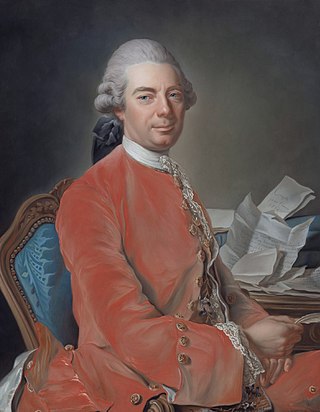
Johann Graf von Fries descended from a Swiss family of bankers. He was a counsellor, director of the imperial silk factories, industrialist and banker. His house in Vienna was the current Palais Pallavicini, built upon a monastery erected by Elisabeth of Austria, Queen of France and closed in 1782.
The Neupauer-Breuner Palace, known in German as Palais Neupauer-Breuner and sometimes referred to only as Palais Breuner by locals, is a Baroque building situated at Singerstrasse 16 in the first district of Vienna in Austria.




















